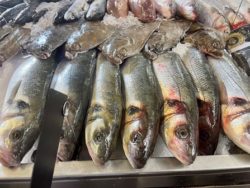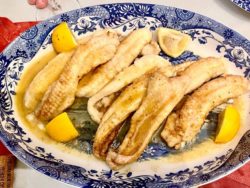Read Time: 4 Minutes Subscribe & Share
Saved By Silt
 In the Before Times, on a visit to our UK Insider, we took a trip to the Portsmouth Historic Dockyards and had two mind-blowing tours of Nelson’s warship, HMS Victory built in 1789, and the HMS Warrior in 1869. This particular post has been one of our most popular Travel Alerts, with well over a thousand views and downloads. The grainy but nail-biting Button Boy video is probably one of its draws. We did not, however, have the time or energy to see the museum dedicated to the remains of Henry VIII’s warship, the Mary Rose, built in 1511 and sunk by a perverse twist of wind and sliding cannons, in the Battle of the Solent in 1545.
In the Before Times, on a visit to our UK Insider, we took a trip to the Portsmouth Historic Dockyards and had two mind-blowing tours of Nelson’s warship, HMS Victory built in 1789, and the HMS Warrior in 1869. This particular post has been one of our most popular Travel Alerts, with well over a thousand views and downloads. The grainy but nail-biting Button Boy video is probably one of its draws. We did not, however, have the time or energy to see the museum dedicated to the remains of Henry VIII’s warship, the Mary Rose, built in 1511 and sunk by a perverse twist of wind and sliding cannons, in the Battle of the Solent in 1545.
On our most recent visit, we finally had time to see the Mary Rose museum and were stunned by the design and execution of its exhibits and theatrical presentation of Henry VIII’s favorite flagship. You become immersed in something real in history, which bears no resemblance to theme park kitsch. Several attempts to raise the ship were made, even after the battle. All of them were to no avail until a painstaking series of over 25,000 dives and massive feats of engineering in the latter part of the 20th century finally rescued part of the ship that had been preserved in the silt of the Solent.
become immersed in something real in history, which bears no resemblance to theme park kitsch. Several attempts to raise the ship were made, even after the battle. All of them were to no avail until a painstaking series of over 25,000 dives and massive feats of engineering in the latter part of the 20th century finally rescued part of the ship that had been preserved in the silt of the Solent.
 The artifacts, including skeletons (even one of the ship’s dogs), possessions, and tools rebuild the lives of some 500 men who died on that ship. Games were played and meals were cooked from a single brick stove for both officers and sailors. Bread was baked, butter was churned, and an astounding amount of beer was allotted daily. Class differences are visible in the dinnerware – wood trenchers for the crew and pewter for the officers. Just to view the close quarters in which they lived and worked is mind-boggling. This detailed video gives you some of the aspects that created this remarkable museum experience.
The artifacts, including skeletons (even one of the ship’s dogs), possessions, and tools rebuild the lives of some 500 men who died on that ship. Games were played and meals were cooked from a single brick stove for both officers and sailors. Bread was baked, butter was churned, and an astounding amount of beer was allotted daily. Class differences are visible in the dinnerware – wood trenchers for the crew and pewter for the officers. Just to view the close quarters in which they lived and worked is mind-boggling. This detailed video gives you some of the aspects that created this remarkable museum experience.
https://www.youtube.com/watch?v=v-4qXi8kXTs
The exhibits include activities for children along its three galleys, and our Anglo-American grandson practiced his bow and arrow skills – we didn’t know that boys from the age of seven during the 16th century were obligated to train in this form of weaponry. Happily, he chose a wood and rope sword (not plastic) as his swashbuckling reward.
British Overload
 Looking back at the first post, my two restaurant recommendations (ABarbistro and Still & West) still stand, but if you want a pretty good
Looking back at the first post, my two restaurant recommendations (ABarbistro and Still & West) still stand, but if you want a pretty good interpretation of Italian coffee (and I am always desperate for any reasonable imitation) as well as sugar-laden British riffs on the American doughnut, look no further than the hipster-by-the-sea cafe, Hideout Coffee Company with its appropriate welcome mat. I recharged my phone and myself while enjoying their version of a cappuccino and a doughnut transformed into a Bakewell tart. Their packaging and downstairs photo booth are a hoot.
interpretation of Italian coffee (and I am always desperate for any reasonable imitation) as well as sugar-laden British riffs on the American doughnut, look no further than the hipster-by-the-sea cafe, Hideout Coffee Company with its appropriate welcome mat. I recharged my phone and myself while enjoying their version of a cappuccino and a doughnut transformed into a Bakewell tart. Their packaging and downstairs photo booth are a hoot.
Seriously Sole
Across from the ABarbistro , my son-in-law guided us to Fish Portsmouth, a seafood shop on the docks that makes me weep with envy. They stay open until they sell out, which is usually in a few hours. One of the difficulties in our marriage is that I love seafood and he loves steak. Until we were introduced to Mas Seafood, any fish or crustacean menu was roundly snubbed by the RWM, (Resident Wine Maniac). His only exceptions were our blue crab cakes and Sole Meunière. We have eaten an excellent Dover Sole Meunière at the Rick Stein Restaurant in Winchester – lovely food, excellent service, and Rick Stein himself writes a mean cookbook.
, my son-in-law guided us to Fish Portsmouth, a seafood shop on the docks that makes me weep with envy. They stay open until they sell out, which is usually in a few hours. One of the difficulties in our marriage is that I love seafood and he loves steak. Until we were introduced to Mas Seafood, any fish or crustacean menu was roundly snubbed by the RWM, (Resident Wine Maniac). His only exceptions were our blue crab cakes and Sole Meunière. We have eaten an excellent Dover Sole Meunière at the Rick Stein Restaurant in Winchester – lovely food, excellent service, and Rick Stein himself writes a mean cookbook.
I have made Sole Meunière with flounder, lemon sole, and occasionally farmed Dover Sole through Browne Trading Company in Portland, Maine. But this was my one chance to make it with a wild caught one (just that morning) with some divine English butter. My son in law, who once worked on a fishing boat in Gosport, boned and skinned the fish, and I created the best Sole Meunière of my life. I can’t get you the same sole, but I can share this recipe.
Sole Advice
 You can remove the gills (and head if you prefer), trim the sets of fins and pull off the skin and sauté the fish whole. Or you can remove the fillets once the skin is pulled off – there are about 4 or 5 to be had. I prefer this to having to remove the bones once it is cooked – although in truth, it’s not that difficult. You should clarify the butter you fry the fish in first, easily done by melting the butter in the pan and then scooping out the “petit lait” or white residue. You must use a pan that responds quickly and evenly to medium heat. I normally use a carbon steel we used to sell in the shop and is currently available from JB Prince (my favorite source for real cooking utensils) It only takes a couple of minutes for a whole sole and less time for the fillets. Spoon the melted butter over the top of the fish as you sauté each side. Have your serving platter warm, lemon juice strained and in a small bowl, your lemons quartered, side garnishes ready (steamed potatoes and sauteed spinach are often served), and your parsley chopped. The RWM loves a white burgundy for this rare treat.
You can remove the gills (and head if you prefer), trim the sets of fins and pull off the skin and sauté the fish whole. Or you can remove the fillets once the skin is pulled off – there are about 4 or 5 to be had. I prefer this to having to remove the bones once it is cooked – although in truth, it’s not that difficult. You should clarify the butter you fry the fish in first, easily done by melting the butter in the pan and then scooping out the “petit lait” or white residue. You must use a pan that responds quickly and evenly to medium heat. I normally use a carbon steel we used to sell in the shop and is currently available from JB Prince (my favorite source for real cooking utensils) It only takes a couple of minutes for a whole sole and less time for the fillets. Spoon the melted butter over the top of the fish as you sauté each side. Have your serving platter warm, lemon juice strained and in a small bowl, your lemons quartered, side garnishes ready (steamed potatoes and sauteed spinach are often served), and your parsley chopped. The RWM loves a white burgundy for this rare treat.


- Usually one whole sole will serve two people, depending on the size.
- 3/4 cup (95gr)white flour
- fine sea salt
- freshly ground white pepper
- 1 lemon quartered
- 1/3 cup (79ml) strained lemon juice
- 1/3cup (79ml)(clarified butter
- 1/3 cup (76gr) unsalted butter at room temperature
- Dry your fish pieces if necessary and then lightly salt and pepper each side.
- Put the flour on a large plate and coat each fillet with flour - you want a thin, even coat.
- I sometimes have to brush off extra clumps of flour.
- Put a fry pan on medium heat and add enough clarified butter to film the pan generously - the butter should bubble and stop before adding the sole.
- Add the fillets, not too close together, cooking until they become a light golden color on each side.
- Remove the fish to a warm platter and gently remove the spent butter from the pan.
- Now add a generous "knob" of room temperature butter to your frypan and allow it to melt, bubble and stop before adding some strained lemon juice.
- Swirl the pan to create a sauce, taste and adjust seasoning before spooning it over the sole fillets on the platter.
- Garnish with lemon quarters and chopped parsley and serve immediately, with steamed potatoes and sauteed tender spinach.
- I prefer freshly ground white pepper with this dish, as it is more subtle in flavor.
- I have tried doing the initial saute in oil, but you don't get the right color or that delicious buttery exterior, obviously.
- Buy the best quality butter, at least for final sauce.

Kitchen Detail shares under the radar recipes, explores the art of cooking, the stories behind food, and the tools that bring it all together, while uncovering the social, political, and environmental truths that shape our culinary world.




Comments are closed here.
Follow this link to create a Kitchen Detail account so that you can leave comments!